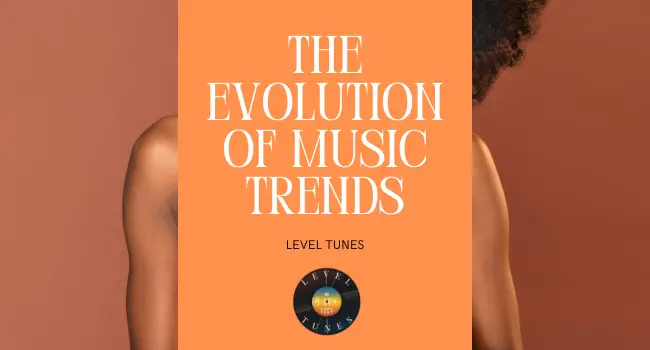The Evolution Of Music Trends
Hey there, music lovers!
As a self-proclaimed expert in the field of music trends, it’s my pleasure to take you on a journey through time and explore the ever-changing landscape of our favorite tunes.
From Beethoven to Bieber, we’ve seen some wild transformations over the years.
It’s fascinating how something as simple as a melody can become so ingrained in our culture that it defines an entire era.
Whether you’re jamming out to disco or headbanging to heavy metal, each genre has its own unique story and evolution.
So sit back, relax, and let’s dive into the history of music trends together!

The Earliest Forms Of Music
Let’s take a trip down memory lane and explore the earliest forms of music.
From banging rocks together to singing in harmony, humans have been creating music for as long as we can remember.
The first instruments were made from natural materials like wood, bones, and animal skin.
These early musical artifacts may not have had the refined sound quality that modern instruments do, but they served their purpose.
As civilizations grew more complex, so did their music.
Ancient Egyptians used harps and flutes in religious ceremonies while Greeks played lyres during festivals.
Music was also used as entertainment during banquets and parties.
It wasn’t until the medieval period that Western classical music began taking shape with the development of notation systems and polyphonic compositions.
Despite all these advancements, one thing remained constant throughout history: people love to make noise!

The Rise Of Pop Music
Pop music has been dominating the charts and airwaves since the early 2000s, ushering in a new era of mainstream success. Its rise can be attributed to its catchy melodies, relatable lyrics, and widespread appeal among younger audiences. Pop artists like Beyoncé, Taylor Swift, and Justin Bieber have become household names thanks to their infectious tunes that have permeated every aspect of our culture from advertising to movies.
With the advent of social media platforms like TikTok and Instagram, pop music has found an even larger audience than before. These apps allow for easy sharing and consumption of short-form videos featuring popular songs which then go viral within hours. This phenomenon is not only driving sales but also influencing fashion trends and shaping cultural attitudes towards identity, gender roles, and sexuality. As such, it’s no surprise that pop music will likely continue to dominate the charts well into the future.
On one hand, some argue that pop music lacks artistic merit due to its focus on commercial success over substance. However, others point out that pop music has always been about escapism and entertainment.
For instance, during times of political upheaval or economic downturns, people crave upbeat songs with simple messages that they can sing along to without having to think too deeply. Additionally, many pop artists are talented musicians who use their platform to shed light on important issues such as mental health awareness or LGBTQ+ rights.
While there may be criticisms leveled at the genre as a whole, it’s undeniable that pop music is here to stay. With its ability to evolve alongside societal changes while retaining its core values of fun and accessibility, the future looks bright for this ever-evolving trend in music history.

The Emergence Of New Genres And Artists
As we saw in the previous section, pop music has dominated the charts for decades. However, as with any trend, there comes a time when people start looking for something new and fresh. This is where the emergence of new genres and artists come into play.
One of the most significant shifts we’ve seen in recent years is the rise of alternative and indie music. These genres have gained popularity thanks to their unique sounds that deviate from mainstream pop. Artists like Billie Eilish, Hozier, and Tame Impala have emerged as powerhouses in this space, bringing an edge to the industry that was missing before.
It’s exciting to see how these artists are pushing boundaries and carving out their own niches within the ever-changing landscape of music trends.
As listeners continue to demand more diversity in their musical tastes, we can expect even further experimentation with various styles and sounds. The merging of different genres such as rap and rock or country and electronic dance music (EDM) will become commonplace. We predict that this blending of styles will lead to some truly innovative works that push beyond what we currently consider ‘popular’ music.
As always, it’s up-and-coming artists who will be at the forefront of these changes while established names shift gears to remain relevant amidst evolving preferences; ultimately leaving us wondering which genre will take over next!

Advances In Technology And The Impact On Music Trends
As music trends continue to evolve, it is impossible not to acknowledge the significant role that technology plays in shaping and influencing these changes. The impact of technological advancements on music has been nothing short of revolutionary, fundamentally altering how we create, produce, distribute, and consume music.
To better understand the effects of technology on music trends, let’s take a closer look at three key innovations:
- Digital Recording: With the introduction of digital recording equipment, musicians were able to record their work with greater precision and flexibility than ever before. This allowed for a broader range of sounds and styles to be explored during production.
- Online Music Streaming: The rise of online streaming platforms like Spotify and Apple Music have made accessing new music easier than ever before. These services also provide artists with valuable exposure opportunities while allowing fans to discover niche genres they may have never encountered otherwise.
- Social Media: Platforms such as Facebook, Instagram, TikTok & Twitter have become essential tools for artists looking to build their fan base or promote upcoming releases by providing them direct access to their audience.
As we move forward into an increasingly digitized world, it will be fascinating to see what other technological developments emerge within the industry – sparking new musical landscapes yet again!
Globalization And The Diversity Of Music Trends
As technology continues to advance, the music industry has witnessed significant changes in recent years. From digital recording equipment to online streaming platforms, these technological advancements have revolutionized how we create and consume music. However, as much as technology has impacted music trends, globalization has also played a crucial role.
With the world becoming more interconnected than ever before, it’s no surprise that different cultures are influencing each other’s musical styles. As a result, there’s now an incredible diversity of music genres available for audiences worldwide. In fact, this table below highlights some of the most popular global music trends:
| Music Genre | Origin | Characteristics |
|---|---|---|
| K-Pop | South Korea | High-energy dance beats with elaborate choreography |
| Reggaeton | Latin America | Spanish lyrics mixed with reggae and hip-hop influences |
| Afrobeats | Africa (specifically Nigeria) | Upbeat rhythms infused with African percussion instruments |
As you can see from the table above, shifts in political power and economic growth have allowed previously underrepresented regions to share their unique sounds with the rest of the world. This cultural exchange has led to exciting collaborations between artists from different continents and contributed significantly to shaping modern-day music trends. So whether you’re into pop, rock or R&B – there’s something out there for everyone!
Frequently Asked Questions
How Have Societal And Cultural Factors Influenced The Evolution Of Music Trends?
Have you ever wondered why certain music trends become popular while others fade away into obscurity?
Well, my friend, it’s not just about the catchy beats or soulful lyrics.
Society and culture play a significant role in shaping our musical preferences.
From the rise of hip hop in the 1980s to K-pop taking over the world today, societal and cultural factors have influenced the evolution of music trends for decades.
It’s like a game of tug-of-war between artists and their audiences – who leads and who follows?
Is it the artist’s unique style that sets them apart from the rest or is it society’s changing values and beliefs that demand something new?
Whatever may be the answer, one thing is for sure: we are all part of this intricate web of influence where music reflects our lives as much as we shape its future.
What Role Have Individual Artists Played In Shaping The Trajectory Of Music Trends?
When it comes to the trajectory of music trends, individual artists have played a significant role in shaping and shifting its course.
From Elvis Presley’s hip-swinging moves that brought rock ‘n’ roll into mainstream culture, to Madonna’s provocative fashion choices that challenged societal norms – these artists have used their creativity and influence to push boundaries and create new sounds.
And let’s not forget about Kanye West, who has arguably redefined what it means to be a rapper with his experimentation with autotune and production techniques.
So whether they’re breaking barriers or challenging our expectations, there’s no denying that individual artists are key players in the ever-changing world of music trends.
How Has The Music Industry Itself Evolved Alongside Changes In Music Trends?
The music industry has gone through some serious changes over the years. Alongside shifts in popular music trends, the industry itself has had to adapt and evolve in order to keep up with demand for new sounds and styles.
From vinyl records to digital downloads, we’ve seen it all – but what does this mean for artists and fans alike? Well, let’s just say that things are looking pretty interesting these days.
With streaming services like Spotify and Apple Music dominating the market, musicians now have more opportunities than ever before to get their music out there. And as for listeners? Well, they’re spoiled for choice when it comes to discovering fresh talent or revisiting old favorites.
All in all, it’s an exciting time to be a part of the music world – so sit back, relax, and enjoy the ride!
What Factors Have Contributed To The Increasing Globalization Of Music In Recent Years?
What’s up, music lovers? Let’s talk about the global takeover of our favorite tunes.
In recent years, we’ve seen a surge in the globalization of music – and it ain’t stopping anytime soon. But why is this happening? Well, folks, there are a few factors at play here.
First off, advances in technology have made it easier than ever for artists to collaborate with others from different parts of the world. Plus, social media has given rise to international fan communities that can spread the word about new artists faster than you can say ‘viral.’
And let’s not forget about the impact of streaming services like Spotify and Apple Music – they’ve opened up access to music from all corners of the globe. So whether you’re grooving to K-pop or jamming out to Nigerian afrobeats, one thing’s for sure: music truly knows no borders.
How Have Advancements In Technology Impacted The Way That Music Is Created, Distributed, And Consumed?
Advancements in technology have undoubtedly revolutionized the music industry, impacting everything from how artists create compositions to how fans consume their favorite tunes.
The rise of digital audio workstations and streaming platforms has made it easier than ever for aspiring musicians to produce high-quality tracks and share them with a global audience.
Meanwhile, social media has enabled artists to connect with fans on a more personal level, creating an unprecedented level of engagement that was once unthinkable.
And let’s not forget about the impact of artificial intelligence and machine learning on the creation process – who knows what kind of wild sounds we’ll be enjoying (or enduring?) in the years to come!
All in All
As a music trends analyst, I can say that the evolution of music has been shaped by various factors such as societal and cultural changes, individual artists’ creativity, and advancements in technology.
From classical to rock to hip hop, every genre has seen its own transformation over time.
The increasing globalization of music is evident through collaborations between artists from different countries and cultures. With digital platforms allowing easy access to music from around the world, listeners have become more open-minded towards diverse sounds.
Looking ahead, it will be exciting to see how new technologies continue to shape the future of music and bring people together through shared experiences.
Thanks for reading.
TBone




